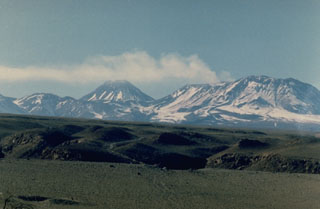Report on Lascar (Chile) — January 1990
Bulletin of the Global Volcanism Network, vol. 15, no. 1 (January 1990)
Managing Editor: Lindsay McClelland.
Lascar (Chile) Landsat data show persistent thermal anomaly despite deflation of lava dome
Please cite this report as:
Global Volcanism Program, 1990. Report on Lascar (Chile) (McClelland, L., ed.). Bulletin of the Global Volcanism Network, 15:1. Smithsonian Institution. https://doi.org/10.5479/si.GVP.BGVN199001-355100
Lascar
Chile
23.37°S, 67.73°W; summit elev. 5592 m
All times are local (unless otherwise noted)
Landsat TM data recorded on 28 November and 14 December show the continued presence of a short-wavelength infrared thermal anomaly in the center of the active crater, despite the deflation of the lava dome that had occurred by 19 October. A roughly circular area four 30 x 30 m pixels in diameter was radiant in TM bands 5 (1.55-1.75 mm in wavelength) and 7 (2.08-2.35 mm) on both images. Several pixels were saturated in both bands, but there was no thermal radiance for the next shorter wavelength (band 4, 0.76-0.09 mm). Temperatures and radiant flux have not yet been calculated, but the general appearance of the data is similar to that of November 1987. There had been no Landsat TM observations of Lascar since then, but it seemed likely that the radiant anomaly has persisted for 5 years, since the first TM image of the volcano was recorded in December 1984.
Geological Summary. Láscar is the most active volcano of the northern Chilean Andes. The andesitic-to-dacitic stratovolcano contains six overlapping summit craters. Prominent lava flows descend its NW flanks. An older, higher stratovolcano 5 km E, Volcán Aguas Calientes, displays a well-developed summit crater and a probable Holocene lava flow near its summit (de Silva and Francis, 1991). Láscar consists of two major edifices; activity began at the eastern volcano and then shifted to the western cone. The largest eruption took place about 26,500 years ago, and following the eruption of the Tumbres scoria flow about 9000 years ago, activity shifted back to the eastern edifice, where three overlapping craters were formed. Frequent small-to-moderate explosive eruptions have been recorded since the mid-19th century, along with periodic larger eruptions that produced ashfall hundreds of kilometers away. The largest historical eruption took place in 1993, producing pyroclastic flows to 8.5 km NW of the summit and ashfall in Buenos Aires.
Information Contacts: D. Rothery, Open Univ.

